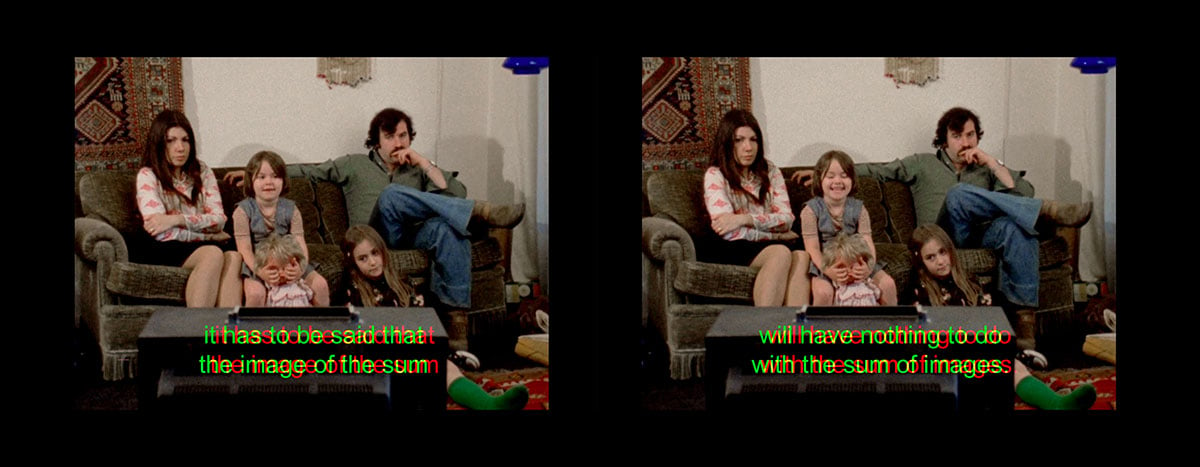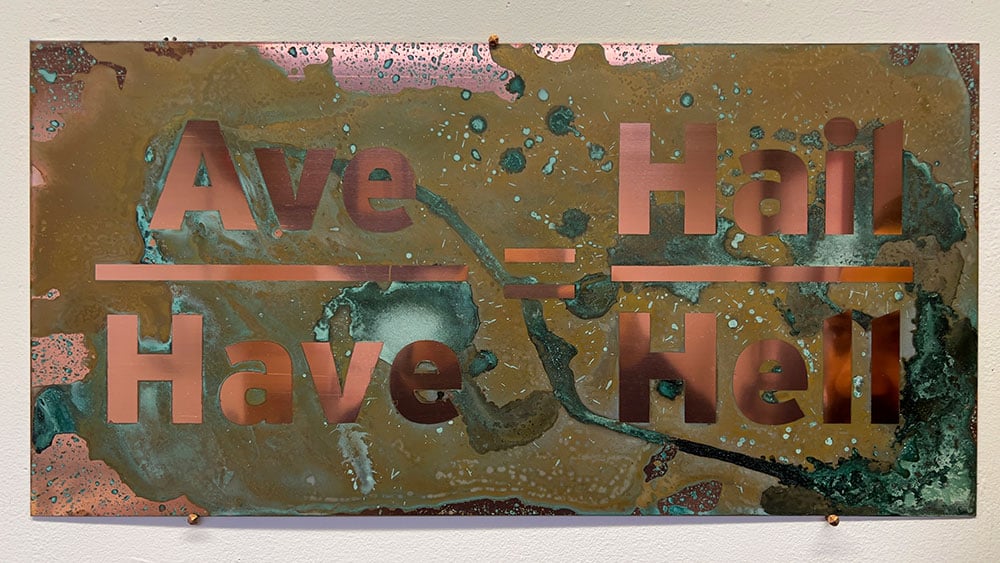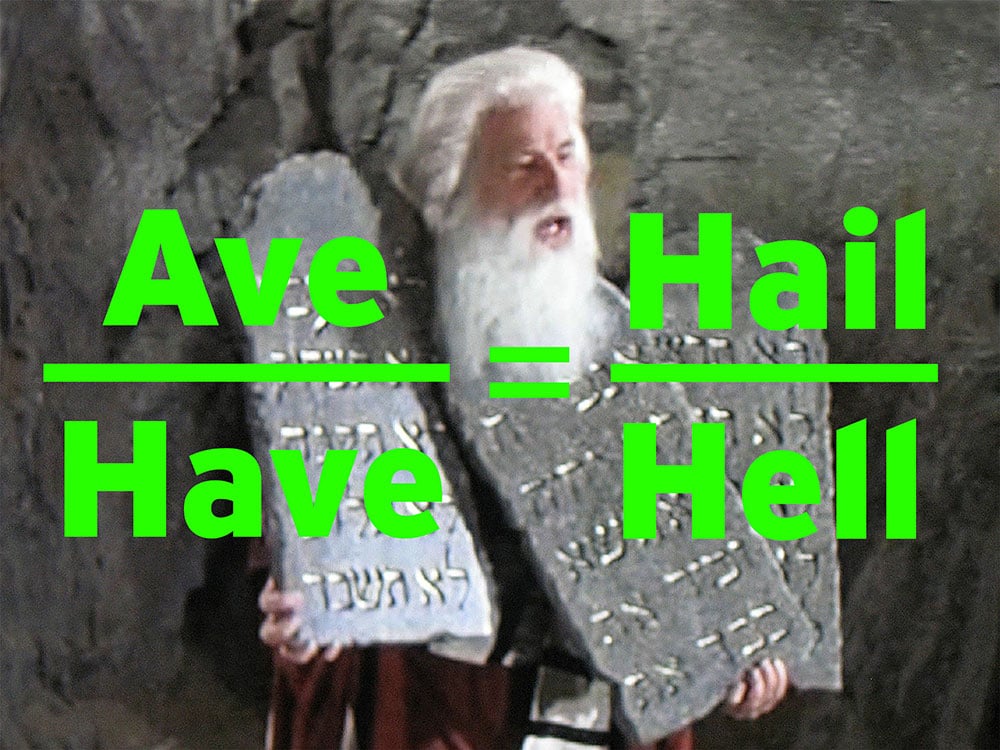Alibaba Conundrum is a show that messes with you. If you’re a person who likes a wee bit of provocation, then head over to the Griffin Art Projects in North Vancouver and prepare for umbrage or elation or both.
Curated by Lisa Baldissera, the exhibition takes its title from the creative partnership of Ali Ahadi and Babak Golkar. The two artists developed the series of different works — film, installations, images, objects — while in residence at Griffin Art Projects. Now it is loosed upon the world. Look out, is all I can say.
The animating concept, put simply, is how the ubiquity/dominance of the English language can make or unmake perception. To make it even shorter: if you can say it, you can see it. But it takes a while to hack through the artists’ statement and descriptions of the different elements in the show to get to the foundational ideas at play.
Reading some of the descriptions from the show might make you want to walk into the ocean and swim out to sea, never to be seen again.
Example:
With the omnipresence of English, every peripheral language (vis-à-vis English) attempting to connect to the world becomes a torsion of English. Therefore, one is either an English-speaking-thinking subject or one is simply defined as the negation of it. In other words, every English-speaking subject is also a non-English-speaking subject, and every non-English speaking subject is definitely an English-speaking subject.
What?
The density. The verbiage. The whack of words. Whatever you would like to call it, it is so over-the-top that one can start to feel a little dizzy. But persevere! Much of the art-speak is leavened with prankster wit and a good dose of silliness. So, with tongue in cheek, we’re off to the racy races.
It begins with good old art shocker and pioneering French New Wave powerhouse Jean-Luc Godard, grandfatherly muse of burgeoning artists and filmmakers everywhere.
The image that provides an entrée to the exhibition is a still from Godard’s 1976 film Here and Elsewhere. In front of the image are two sets of 3D glasses. When worn, they reveal a line of text floating in mid-air that says, “It has to be said that the image of the sum will have nothing to do with the sum of images.”
A quick peek at the film’s trailer will provide additional context in good Godardian fashion, meaning it probably won’t help at all.
Thank God for Mel Brooks.

The heart of the exhibition is a 20-minute film entitled 10+ (-5) Commandments that took inspiration from Brooks’s 1981 comedy History of the World: Part 1, where the director plays Moses presenting the 15 commandments he has received from God. After dropping one sacred tablet, the original list of 15 commandments gets whittled down to 10. Which brings us to present day.
The 10+ (-5) Commandments film provides a thorough grounding in everything that comes afterwards in the show, so pay attention, goddamn it! It’s pretty much all in there, exploding out like a pop-up clown in a funhouse mirror.
One of the largest images in the exhibition is a wallpaper recreation of a group of men conjoined in the most intimate fashion. In the common vernacular/parlance, I believe the expression is “daisy-chain.” Look that up at your own discretion.
The image, taken from Tuhfet Ul-Mulk, an erotic manuscript that was created for the delectation of the royal sultan, depicts a collection of men having group sex. One young cavorter fixes viewers with a somewhat glazed expression. This image is replicated again in partnership with Manet’s famous painting A Bar at the Folies-Bergère.
Kitty corner to the sex circle depicted in Shaykh Muhammad Ibn Mustafa Al-Misri’s illustrated manuscript is a film still from influential Italian director Pier Paolo Pasolini’s Salò, or the 120 Days of Sodom. Adapted from a story by the Marquis de Sade, the film tells the story of a group of 18 teenagers captured and confined by a quartet of older fascists. They are forced to undergo acts of sexual torture and ritual degradation.
Released in 1975, a few weeks before Pasolini was himself murdered, it has lost none of its corrosive power and is still banned in countries around the world.
Separated by centuries, the shock of sex still stands. The erotic manuscript commissioned for the sultan demonstrates not only sex acts, but also power dynamics. So, too, Salò. In some fashion, the power to see or deny others the chance to see is one of the most interesting aspects explored.
It reminded me of the apocryphal story that the largest collection of pornographic art in the world resides in the bowels of the Vatican. This may or may not be true, but in the internet age, the notion that these works are still squirrelled away from public view is fascinating stuff.
Sometimes they’re right out in the open.
A reproduction of Gustave Courbet’s painting The Origin of the World is a case in point. It’s still a bit of a discombobulating moment to come around the corner at the Musée d’Orsay gallery in Paris and run headlong into the painting. Alibaba Conundrum pairs Courbet’s painting with a distorted blown-up section taken from the Godard film, wherein a little girl is seen punching the plastic face of her baby doll. It’s a detail that easily escapes initial notice, but when repurposed, it takes on new meaning and entirely different connotations.
Staggering away from these first encounters in the show, the disorientation continues with It Flashes. The work consists of a black box construction that mostly resembles a darkened phone booth or a one-person sauna. Enter into the curtained-off interior, and a certain word flashes on to your retinas and stays there for a few seconds.
Another related perceptual shift takes place with Alibaba’s Perspective, which consists of a tripod, a camera and a wee bit of unexpected surveillance. Not to spoil anything about the experience, but you might be in for something of a surprise.
The mixture of high and low continues in other pieces like Ave is to Have as Hail is to Hell, a copper plate with the title words flashing metal bright. Historically, urine was used to oxidize copper paint, creating green-grey colouration, not dissimilar to the particular hue of the Statue of Liberty. Andy Warhol’s Piss Paintings might be the most famous example of this colour change.
Despite the rather outré origins, the liquid splashes on Ave is to Have as Hail is to Hell possess a complex beauty. Ornate and rococo and a bit icky.

It's a quality that is replicated in other works like English (Triggerrrrrrrrrrrrrg) that depicts a hairy human arm grasping a silicone hand. In addition to the fetishistic aspects of the image itself, it loops back around to some of the earlier pieces in the show, including the opening image of the little girl and her dolly with the punched in face.
There’s a lot packed in, from semiotics to art history, with a little lite spanking of sex and power. Looking at the collected works, it’s tempting to fall down the rabbit hole of references, allusions and outright quotation.
But to circle back around to the ethos of the show itself, does all this stuff obstruct the central idea? Namely, that if language constructs reality, whose language and whose reality?
This funhouse inversion that occurs throughout the show is far and away its most enjoyable aspect. So surrender yourself to the experience. But is there any greater takeaway, other than playfulness with content and form? It is all something of an elaborate prank on the viewer themselves? There are a number of clues that indicate that the intention isn’t exactly straight-up.
Even the word “conundrum” itself is something of a puzzler, according to Grammarist: “The origin of the word conundrum seems to be at Oxford University in the 1590s, as a coined nonsense word. Among the learned at this time, conundrum was a pseudo-Latin word that was used to mean a silly, fussy person.”
For all of the show’s complexity and intelligence, the circling ideas all whirling about sometimes fail to land. A good art poking is all fine and good, but things are almost too clever for their own good. After all this relentless provocation, what are you supposed to get?
To be frank, I’m not exactly sure. I guess it largely depends on what you come in with, but the sum of the show itself has something to do with the sum of images. I think.
The problem with playing with language is that sometimes language can play with you.
Uh oh… now I’m doing it.
‘Alibababa Conundrum’ is on view at Griffin Art Projects at 1174 Welch St. in North Vancouver until May 7. ![]()
Read more: Art, Gender + Sexuality, Media

















Tyee Commenting Guidelines
Comments that violate guidelines risk being deleted, and violations may result in a temporary or permanent user ban. Maintain the spirit of good conversation to stay in the discussion.
*Please note The Tyee is not a forum for spreading misinformation about COVID-19, denying its existence or minimizing its risk to public health.
Do:
Do not: